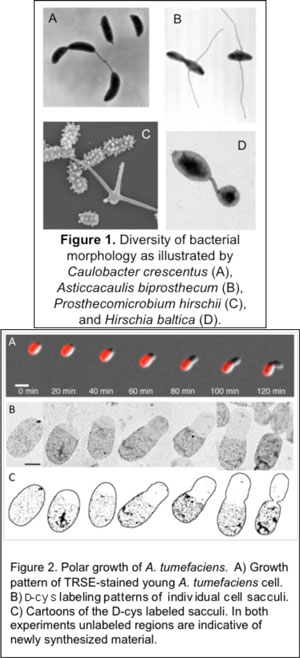Dr. Pamela Brown
Dr. Pamela Brown

PhD, 2006 University of Georgia
Molecular basis for polar growth in Agrobacterium tumefaciens
My lab is interested in understanding the principles that govern bacterial morphology, a readily observable facet of microbial cell biology. One of the major unsolved questions in microbiology is how bacteria generate specific shapes. Bacteria exhibit an amazing diversity of shapes and sizes that are precisely reproduced at every generation, indicating that morphology plays an important role in the life of these bacteria (Figure 1). Impressive progress has been made in the past few years in understanding the mechanism of cell shape determination in a few model bacterial systems, including the discovery that bacteria possess a cytoskeleton, but we are still very far having a comprehensive understanding of how bacterial morphologies are generated. My lab takes advantage of recent technical advances in microscopy, construction of fluorescent fusion proteins, and high throughput sequencing, to make strides in understanding how bacteria generate specific morphologies.
In most bacteria, the cell wall is comprised of peptidoglycan and is a major determinant of cell shape. In a majority of rod-shaped bacteria, including E. coli, cells elongate by the lateral insertion of newly synthesized peptidoglycan along their sidewalls. In contrast, some rod-shaped bacteria utilize precise targeting of peptidoglycan to specific polar locations to enable cell elongation. Indeed, we have previously shown that constrained polar growth is responsible for elongation in many species of Rhizobiales, including Agrobacterium tumefaciens (Figure 2). My lab uses A. tumefaciens, a well-studied plant pathogen and causative agent of crown gall disease, as a model to understand how bacteria constrain peptidoglycan synthesis to specific cellular localizations. Presently, we are focused on addressing two key questions:
- What is the mechanism underlying polar growth of A. tumefaciens?
- What are the ecological and evolutionary benefits imparted by polar growth?
Knowledge gained though these studies will then be applied to enhance our understanding of the precisely targeted growth in other Alphaproteobacteria, including those that display remarkable morphologies. Our goal is to better understand the role of zonal peptidoglycan synthesis in generating both relatively simple and dramatically complex bacterial shapes.
William T. Kemper Fellowship for Teaching Excellence, 2025
College of Arts and Science Associate Professor of the Year Award, 2024
Maxine Christopher Shutz Award and Lecture for Distinguished Teaching, 2023
Outstanding Undergraduate Research Mentor of the Year 2021
Alumnae Anniversary Fund for the Recognition of Faculty Women Award 2020
Dr. Abraham Eisenstark Faculty Fellowship Award in Biological Sciences 2018
Mr. & Mrs. Shouson & Yunying-Kou Jen Junior Faculty Research Award in Biology 2017
Provost’s Outstanding Junior Faculty Teaching Award 2016
College of Arts and Science Purple Chalk Teaching Award 2015
Ruth L. Kirschstein National Research Service Award Postdoctoral Fellowship 2007
University of Georgia Outstanding Graduate Research in Life Sciences Award 2006
University of Georgia Outstanding Teaching Assistant Award 2004
Joy Williams Porter Graduate Fellowship Recipient 2003
Achievement Rewards for College Scientists (ARCS) Fellowship Recipient 2002
University of Georgia Presidential Fellow 2000
A list of Dr. Brown's publications is available from Google Scholar.
